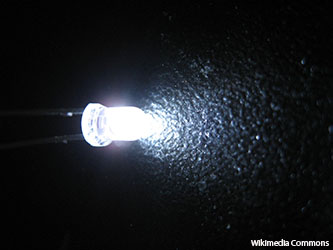
With today's explosive growth in solid-state lighting, optimizing white LEDs to emit the desired color of light has become crucial. To determine the necessary structure of the phosphor-and-semiconductor stack of such LEDs, researchers have been using computationally intensive methods such as ray tracing and Monte Carlo simulations.
Scientists at the University of Twente and Philips Research in the Netherlands have derived the transport and absorption mean free path within white LED structures from first principles (Opt. Express 22, 8190). Applying this method could help engineers design new LED luminaires with less trial and error.
White LEDs consist of a semiconductor diode that emits blue light and a phosphor layer that converts some of the blue rays to yellow and red, so that the overall emission appears “white” to human eyes. Last year a group led by OSA Fellow and Twente professor Willem Vos used Mie theory to model the transport mean free path through the structure of an LED, but that model did not account for absorption or emission.
The Twente group, led by Vanessa Leung (now at the University of Basel, Switzerland), measured the optical properties of five polycarbonate plates containing varying densities of crystalline particles of cerium(III)-doped yttrium aluminum garnet, which is used as the phosphor in many white LEDs. They used diffusion theory to interpret the experimental results.
The analysis revealed that light passing through the samples had roughly identical transport and absorption mean free paths that were also comparable to the thickness of the sample plates. The system had an albedo of about 0.7. The team also mapped the optical parameters into the color space of the uniform chromaticity diagram most often used in optical engineering to show how the parameters were related to an emitter at a desirable color temperature of 5,000 K.
